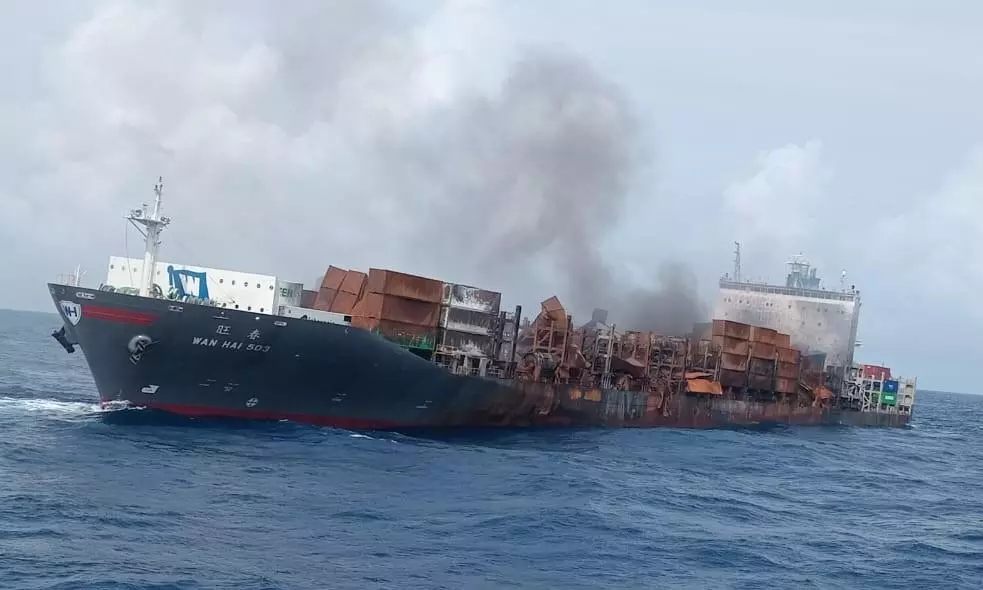
Twin wrecks continue to threaten Kerala coast, with nurdles and unknown cargo
While 280-odd containers with incomplete cargo declarations aboard the Wan Hai 503 remain a safety concern, the MSC ELSA 3 has been releasing plastic nurdles

As the salvage operation aboard the Wan Hai 503 progresses 122 nautical miles off the Kerala coast, another maritime emergency continues to unfold around the sunken vessel MSC ELSA 3. While offshore efforts focus on wreck-site readiness and floating container tracking, coastal authorities are dealing with the environmental aftermath — a persistent spread of plastic nurdles washing up near the shoreline.
The situation onboard the Wan Hai 503 has entered a more controlled phase. On Monday (June 30) morning, the salvage team boarded the ship and began pumping out water from its heavily flooded engine room. Support vessels Saksham, Saroja Blessings, and Water Lily remain deployed for firefighting, cooling, and logistics. The tug Offshore Warrior continues towing the ship further into international waters, beyond the Indian Exclusive Economic Zone, under moderately rough seas and 16-knot winds.
Smoke and water
Light smoke is still rising from the vessel’s forward section, prompting boundary cooling to continue in rotational shifts. On-site conditions have stabilised, but fire and structural risks remain.
Also read: Challenges galore before twin maritime salvage missions off Kerala coast
A salvage team member confirmed: “The engine room is flooded up to 7 metres, mostly due to ingress of seawater used during firefighting. We’ve now stopped using water to prevent further flooding. The vessel is listing to the port side, likely because of the weight loss from burned cargo or the internal shape of the engine room, which is retaining water. Equipment has been loaded on Wan Hai to begin dewatering. Boundary cooling continues to maintain structural integrity and prevent any risk of BLEVE.”
A BLEVE — Boiling Liquid Expanding Vapour Explosion — is a serious hazard where a heated, pressurised container ruptures and the liquid rapidly turns to vapour, sometimes causing fireballs or secondary blasts. The risk, though low at this stage, is enough to justify the current cooling protocol.
Opaque records make it impossible to rule out the presence of flammable or hazardous materials within the sealed containers on board the Wan Hai 503
A safety concern
The fire aboard Wan Hai 503, which broke out on June 9, killed four foreign seafarers and damaged hundreds of containers. According to the latest situational report issued by the director of shipping, power has since been partially restored and onboard systems are functioning at 75 per cent capacity.
But the presence of more than 280 containers with incomplete cargo declarations remains a safety concern. These opaque records make it impossible to rule out the presence of flammable or hazardous materials within the sealed containers.
As cooling and dewatering continue, inspections will determine if the vessel can be moved for repairs or scrapping. Until then, salvage crews remain in and out on board in shifts, working amid high humidity, residual heat, and compromised structural conditions.
Also read: Kerala: Tow line secured on burning cargo ship in major salvage breakthrough
Nurdle hurdle
Meanwhile, the story of MSC ELSA 3 has taken a different, yet equally worrying, turn. The vessel, which sank offshore in an earlier incident, has sparked potential environmental hazard following the release of plastic nurdles — small raw plastic pellets used in manufacturing.
Though onshore recovery operations have stabilised, pellets continue to wash up in bags along parts of the coastline. Drone and field surveillance teams are being deployed daily to identify new hotspots.
While authorities and volunteers have recovered significant quantities of the floating pellets, a clear and final disposal mechanism has yet to be formalised. Coordination is ongoing between MSC, Customs, and pollution control agencies. The Directorate General of Shipping has called for detailed master logs on the recovered nurdles, updated status reports on containers lost, and official protocols for disposal.
The charred insides of the Wan Hai 503
Patrols continue
The offshore monitoring around the MSC ELSA 3 wreck has seen a positive development with the deployment of Canara Megh, a vessel assigned to wreck-site observation and floating container recovery. However, the timeline for oil extraction from the sunken ship and full-scale wreck removal remains uncertain. The operations depend on the mobilisation of a new contractor recently engaged by MSC.
Patrols by the Indian Coast Guard continue both from the air and by sea. No significant changes had been reported by Monday, but the situation remains fluid, especially given the risks of monsoon-driven spread of debris and plastic.
Also read: Burning cargo ship off Kerala coast poses serious toxic threat, sparks concerns
Maritime risks
The incidents involving Wan Hai 503 and MSC ELSA 3 reflect the broad range of maritime risks facing global shipping today — from on-board fires and mechanical failures to environmental disasters stemming from cargo mishandling and unclear declarations.
While Wan Hai 503 is being towed farther into open water to reduce immediate threats to India's coastline, MSC ELSA 3 presents a longer-term problem closer home. The risk is not from fire or capsizing — but from nurdles and oil potentially escaping into coastal ecosystems. Plastic nurdles are notoriously difficult to contain once dispersed. They resemble fish eggs, making them prone to being eaten by marine life, and they’re almost impossible to clean from sand and rocks once embedded.
For MSC ELSA 3, attention now shifts to documentation, cleanup logistics, and a race against the monsoon. If nurdle bags continue surfacing, containment may give way to widespread contamination — and with it, public pressure on both regulators and shipping companies to respond more swiftly and transparently.

